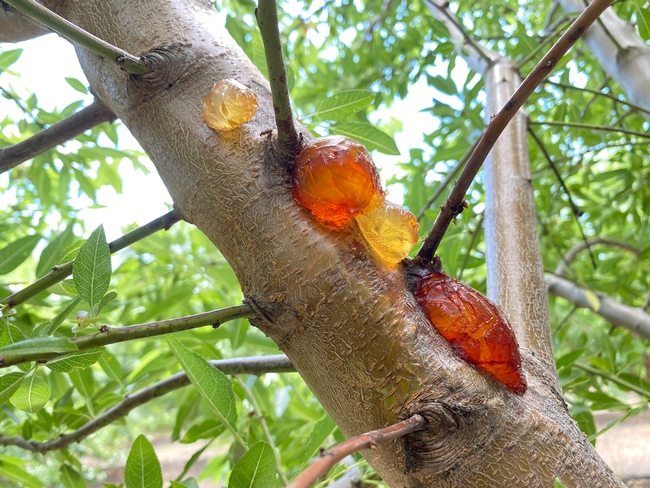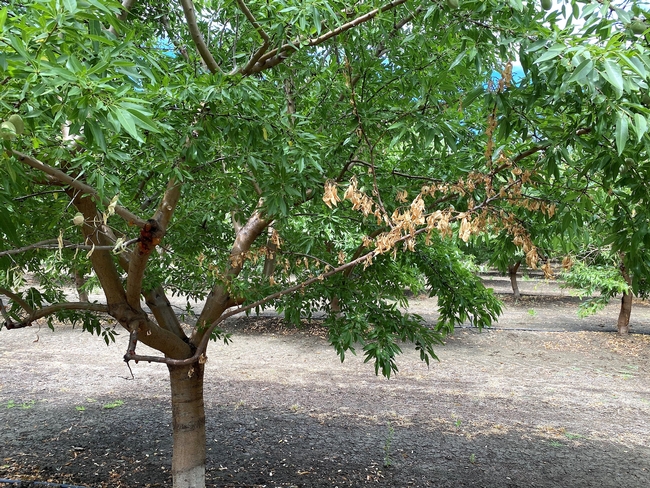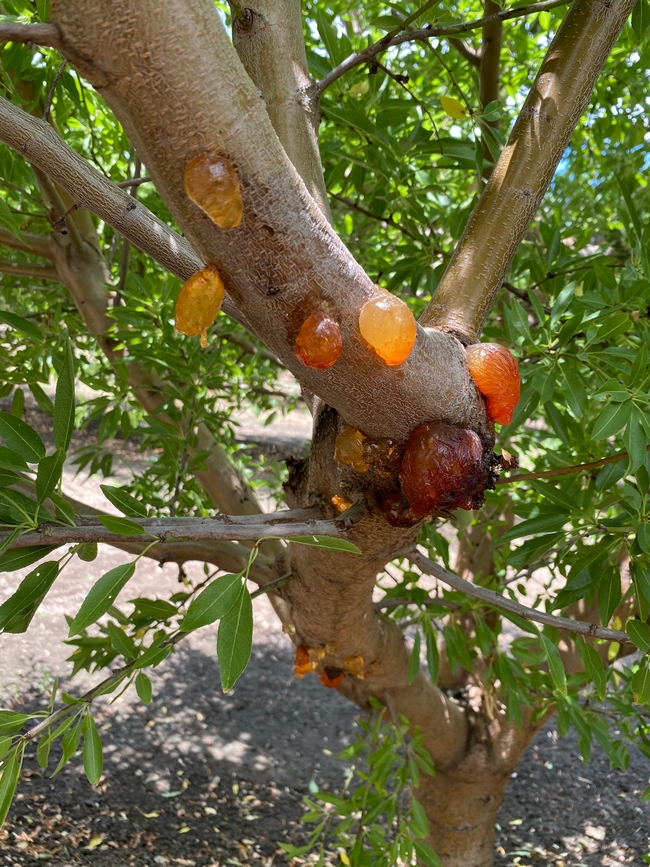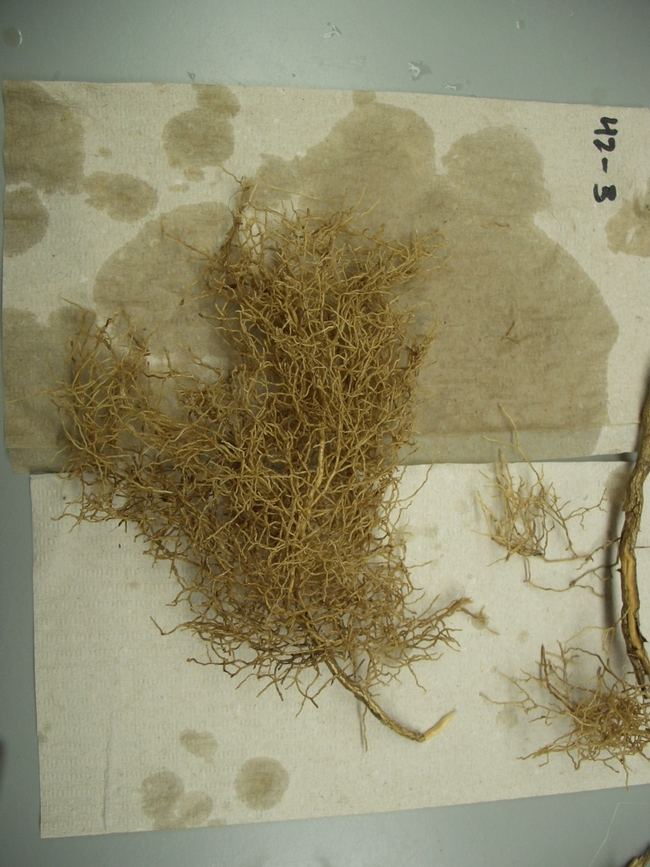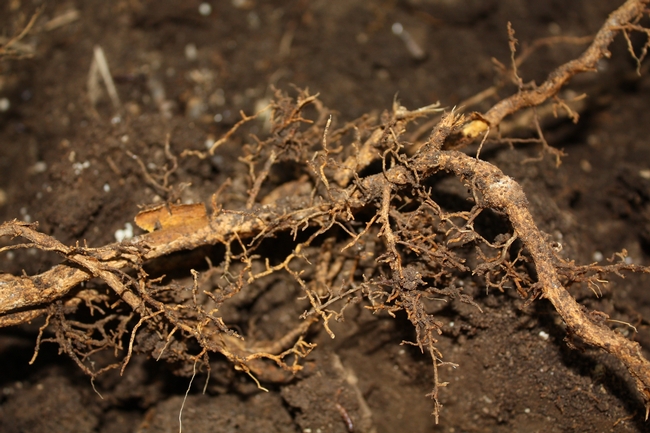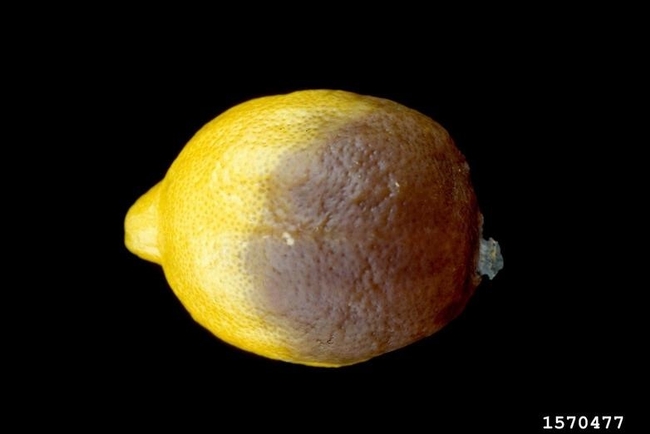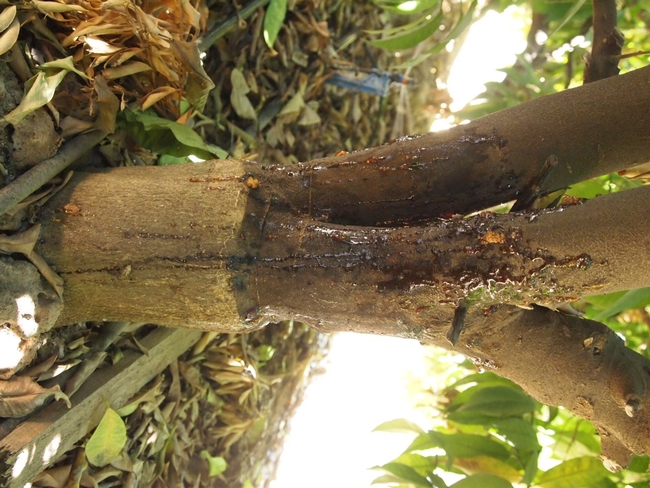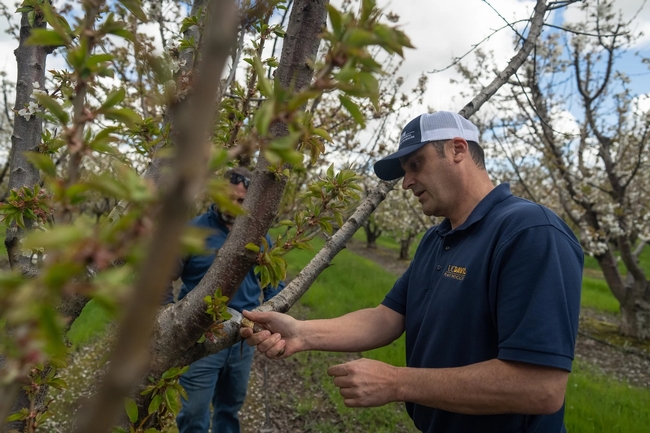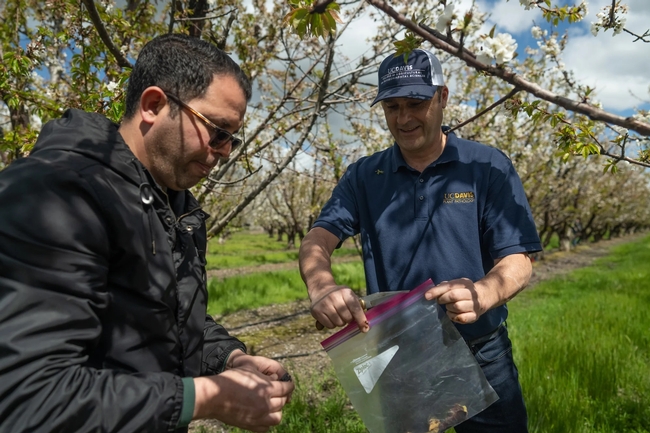Posts Tagged: phytophthora
Lawn-pocalypse! Surviving Drought
Ah, summer! The season of sunburns, pool parties, and… lawn droughts. If your once lush, green carpet now looks like a crunchy brown doormat, you're not alone. Let's dive into why your yard is staging a dramatic death scene and what you can do to...

Bermuda grass and weeds overtaking drought stressed turf grass.
Almond growers should prepare for possibility of unusual disease outbreak
Wet winter, El Niño create favorable conditions for aerial Phytophthora pathogen
With heavy rains in the forecast amid strengthening El Niño conditions, almond growers should be on the lookout for a rare disease that can cause severe damage to their orchards, according to Florent Trouillas, a University of California Cooperative Extension specialist in fruit and nut pathology.
Phytophthora, soilborne microorganisms dubbed “water molds” because of their dependence on water, typically cause root and crown rot at the base of trees. But a few aerial Phytophthora can travel upwards and infect the higher parts of the tree. One species – Phytophthora syringae – is drawing special attention due to an unprecedented outbreak last winter, fueled by the atmospheric rivers that lashed California.
“It was found statewide – meaning in every almond-producing county – and disease incidence in orchards ranged from 10% of the trees infected to 75%,” said Trouillas, a UC Davis plant pathologist whose lab is based at UC Agriculture and Natural Resources' Kearney Agricultural Research and Extension Center in Parlier.
Trouillas and his colleagues, UC Davis graduate student Alejandro Hernandez and UC Riverside plant pathology professor Jim Adaskaveg, recently published a detailed online article describing the pathogen, which can infect a range of crops but mainly impacts almonds in California.
Although it doesn't kill the tree, the disease causes branch dieback that requires significant additional work and expense for almond growers. In 2022, almonds were the state's fourth-highest valued commodity, at $3.52 billion.
During last year's aerial Phytophthora outbreak, researchers also observed a new and troubling phenomenon: P. syringae, historically known to attack the cuts caused by pruning, was directly infecting the young shoots on almond trees – without any wounds.
“This was really the first time we had seen widespread evidence of infection on the twigs,” Trouillas said.
Although generally rare, outbreaks of P. syringae have been traditionally associated with wet El Niño years, according to Trouillas – and recent and persistent rain across the state should have growers on high alert.
Prune in dry weather, monitor, mitigate if necessary
While almond growers tend to prune during the downtime of winter, they should keep an eye on the forecast and aim for a 10- to 14-day window of dry weather to perform those tasks, whether training young trees or maintaining the established ones.
“If growers were to prune around a rain event – before, during or shortly after – this increases the likelihood of infection because this pathogen moves around with water,” Trouillas explained.
Researchers speculate that P. syringae, normally found in the soil, gets carried into the upper parts of a tree through strong winds and heavy rain. Alternatively, harvest processes like shaking and sweeping also produce air movements that may blow the microorganism into the canopy, where it waits for a favorable wet environment. The pathogen then attacks the wounds or young shoots, producing characteristic cankers and gumming.
The patterns and colors of the gum balls are keys to diagnosing an infection of this particular aerial Phytophthora. Starting around bloom time (mid-February), growers should monitor pruning wounds and young shoots on their trees, especially in the canopy, for signs of the disease.
The unique coloration of the gum balls – ranging from gold and amber to dark burgundy to bright red (see photos) – generally indicates P. syringae infection. But growers are urged to contact their local Cooperative Extension advisor for confirmation.
“It is super critical for growers that, whenever they see gumming, not to assume that it is this aerial phytophthora, because there are many other diseases that can cause gumming on the tree,” Trouillas said.
If the diagnosis is confirmed, growers may apply a compound that can mitigate the infection. The plant pathologists' recent writeup describes several curative treatment options, as well as a preventive measure that reduces the amount of pathogen in the soil and thus the likelihood of infection.
For more information on the pathogen's history and biology, as well as various options for disease management, visit the article on Sacramento Valley Orchard Source: https://www.sacvalleyorchards.com/almonds/trunk-soil-diseases/aerial-phytophthora-outbreaks-in-wet-years.
Phytophthora Diseases of CA Citrus
There are at least four species of Phytophthora species (P. citrophthora, P. parasitica, P. syringae, and P. hibernalis) associated with citrus in California and all species can cause various symptoms in citrus including the three main ‘diseases' associated with Phytophthora spp. The three diseases in citrus caused by these fungal-like pathogens are; Phytophthora Root Rot, Phytophthora Brown Rot of citrus fruits both pre-and post-harvest, and Phytophthora gummosis, which causes a canker at the lower area of the tree usually at or around the soil line. These organisms are active within the field essentially all year long so one tree could possibly have all three disease symptoms at one time but this is usually not the situation. These pathogens are also ubiquitous within the soils of California citrus groves so keeping an eye out for these diseases is essential to help manage these citrus issues.
Phytophthora Root Rot (PRR): PRR is caused primarily by P. citrophthora and P. parasitica. The former is most active in the winter with respect to PRR whereas the latter is more active in warm weather so PRR can be found throughout the year. This disease can affect young to mature trees and is often associated with groves that do not have good drainage such as high clay soils. For example, in the Terra Bella area of the San Joaquin Valley, there are areas with high clay soils that lead to problems with PRR due to the lack of drainage which can also lead to additional disease issues such as Dry Root Rot (Fusarium solani). In fact, both pathogens seem to work in tandem because Phytophthora can weaken the trees by destruction of the feeder roots leading to colonization by Fusarium solani and both pathogens can often be isolated in these situations.
Both pathogens are common throughout most citrus grove soils and can survive for years in the soil by producing persistent spores (clamydospores). When moisture is present in the soils, these pathogens can then produce oospores which are the reproductive spore stage. Oospores will differentiate into motile swimming zoospores that are released by the oospores and swim in the free water in the soil towards the primarily feeder roots. These motile zoospores are the infective spores which can decimate the citrus root system leading to potential death of the tree.
Trees that are infected with this disease will often show light green to yellowing of the leaves, thinning of the canopy, and often causes a slow decline of the tree once infected (Fig 1). The trees decline because the feeder roots get destroyed so the plant cannot uptake water and nutrients effectively, thus leading to potential death of the tree. If PRR is the potential suspect of decline, it is possible to dig up roots to evaluate them because this pathogen mostly infects the feeder roots below the soil line within a foot or so from the surface of the soil line. Figure 2 shows what a healthy root system looks like as well as a root system infected by the pathogen. The colonization of the feeder roots is primarily within the root cortex which becomes soft and disintegrates these cells which makes it easy to separate this tissue layer from the stele of the feeder root.
Root rot can also lead to other diseases due to stressing the plants once feeder roots are consumed by Phytophthora. For example, Fusarium solani, which causes dry root rot in citrus is a secondary pathogen that usually only infects citrus once the trees are under stress. Moreover, if the citrus trees are already infected with Citrus tristeza virus (CTV), the combination of CTV and F. solani can play a major role in quick decline of citrus on sour orange rootstock. Other viruses or viroids may also play a role in this interaction but no studies that we are aware of have tested this specifically.
Fig 1. Yellowing and thinning of citrus canopy due to Phytophthora infection.
Figure 2. Healthy root system of a citrus plant (top)
and a root system infected with Phytophthora showing decay of the feeder root system (bottom).
Brown Rot: This disease is caused by the various Phytophthora spp. and is usually associated with mature fruits. However, twigs, leaves, and flowers can also occasionally be infected which can result in death of these tissues. This disease is usually associated with cool and wet conditions. The symptoms can be seen in the field, primarily on low lying fruit because the spores of the pathogen can get dispersed with water and wind and move from the soil to the low-lying fruit in the tree (Fig 3). Therefore, it is recommended to ‘skirt' the trees so that there is no low-lying fruit to get infected. Brown rot can also occur after the fruit is picked (not showing symptoms) so it is also a post-harvest issue as well. In this situation, fruit that does not show obvious symptoms may be picked and stored at the packing house and the disease can spread to healthy fruit during storage.
Fig 3. Brown rot symptoms of Phytophthora on a lemon fruit.
Phytophthora Gummosis (PG): This disease is caused by the various Phytophthora spp. This disease is usually only seen around the soil line to a foot or so above the soil line but could produce a larger canker higher up the trunk (Fig 4). The disease is recognizable because once infected, the tree starts to produce compounds to combat the infection which results in oozing of sap from small infected cracks in the bark which may look as if the tree is bleeding. The bark usually remains firm but dries out and eventually cracks and can slough off the trunk. Sometimes a white crust appearance will also be seen within and around the canker. Once an infection occurs and the tree is not treated, the canker can eventually spread around the circumference of the trunk that can lead to complete girdling of the tree. This can weaken the tree leading to general decline and or kill the tree which can occur within a year under favorable conditions (moist and cool) but usually will take several years of active infection to cause major damage.
Figure 4. Gummosis symptoms on lower trunk of a citrus tree. Note that the scion is more susceptible than the rootstock because most growers use Phytophthora tolerant rootstocks.
General information on control of Phytophthora diseases. If a grower has a field that has had a history of various Phytophthora issues, there is the possibility to do a pre-plant fumigation using metam sodium or chloropicrin. If a grove becomes infected after planting, the most common methods of control are the use of chemicals usually applied through the drip lines. The most common products are Aliette, Ridomil Gold, and Prophyt. In the last several years, another product (Orondis), as well as some other chemistries, have been developed to control Phytophthora diseases. In this study, minimum effective rates to reduce Phytophthora root rot incidence and pathogen soil populations were determined after one and two applications in fall 2016 and summer 2017, respectively, and greenhouse studies confirmed the efficacy of the new fungicides. These findings led to fluopicolide recently receiving a federal and oxathiapiprolin (Orandis) a full registration for use on citrus. The researchers also requested that ethaboxam and mandipropamid also be considered for registration for control of Phytophthora diseases of citrus in CA. These new compounds will provide highly effective treatments and resistance management strategies using rotation and fungicide mixtures for the control of Phytophthora root rot of citrus.
Micronutrient sprays that contain phosphite may also help to control these diseases because this molecule stimulates a systemic inducedresistance response in the citrus trees that helps the plant fight off infections. The new compounds will provide good control when used in a rotation to avoid resistance, as has happened with many older products. For additional information regarding these new options for control of Phytophthora root rot of citrus, see. (https://apsjournals.apsnet.org/doi/10.1094/PDIS-07-18-1152-RE).
More details on Phytophthora and its control can be found at the UC IPM website; https://www2.ipm.ucanr.edu/agriculture/citrus/?src=redirect2refresh.
Winter atmospheric rivers gave pathogens, diseases path to infect crops
Outbreaks similar to El Niño-influenced issues of the 1990s
The wave of atmospheric rivers that swept across the state this winter has created the right conditions for plant pathogens that haven't been seen for decades in California. University of California, Davis, plant pathologist Florent “Flo” Trouillas is getting more calls from growers and farm advisors concerned about potential crop damage.
“Generally, whenever you have rain events, you're going to have problems,” said Trouillas, a Cooperative Extension specialist who is based at the Kearney Agricultural Research and Extension Center in Parlier. “In wet years we get really busy because most pathogens need and like water.”
Trouillas is like a disease detective. He splits his time between the field and the lab, working to diagnose pathogens, diseases and other ailments that strike fruit and nut crops such as almonds, cherries, olives and pistachios.
On a recent visit to an almond orchard near Fresno, Trouillas joined Mae Culumber, a nut crops farm advisor for UC Cooperative Extension Fresno County. A few weeks earlier, the two had walked the orchard, taking note of the base of some trees that had gumming — a thick, jelly-looking substance indicating a pathogen had taken hold.
“A lot of what Florent is doing is trying to assess patterns on a landscape,” Culumber said. “Sometimes things may look like they are one thing, but it could be another problem.”
When the two returned weeks later, the amber-colored gumming had moved into the canopy, looking like gumballs stuck to branches, some of which were already dead. “It's getting out of control from before,” Trouillas says. “This branch was killed. This is widespread.”
From the field to the lab
Lab testing confirmed what Trouillas believed was the culprit: Phytophthora syringae, a pathogen that can affect almond crops but is rarely seen in California. If it is found, generally the site of infection are wounds caused by pruning, but that is not the case here, where the infection began in the canopy at twigs, or small branches.
It is a threat to a key crop, which according to the California Department of Food and Agriculture, generates $5 billion annually. The last time Phytophthora syringae hit California was in the 1990s after a series of El Niño-influenced storms. Trouillas, who has a photographic memory, remembered reading about it in an old manual.
“It's rare for California and one that we see mostly following atmospheric rivers,” he says.
“The disease will only happen following these extremely wet winters.”
Phytophthora is soilborne, mostly found in tree roots, and doesn't generally spread up into branches. But the intense storms created the right conditions for the pathogen to “swim” up trunks as winds blew spores into the air and rain dropped them back down into the canopy, Trouillas said.
Some of the trees in this orchard will die; others can be saved by pruning infected branches and applying a recommended fungicide, he said.
Identification, diagnosis, education
Trouillas is one of more than 50 Cooperative Extension specialists at UC Davis and each is charged with identifying problems and developing solutions for those issues in support of agriculture, the ecosystem and communities throughout the state.
In his role, Trouillas focuses not only on pathology and research but also on educating growers, nursery staff, pest control advisers and others in agriculture about ways to manage potential threats and how to prevent crop damage.
“His role is very crucial,” said Mohammad Yaghmour, an orchard systems advisor for UC Cooperative Extension Kern County. “He's not only on this mission to educate growers but he's also a source of education for us.”
Trouillas typically conducts one or two site visits a week, usually after a farm advisor reaches out about a problem they can't solve on their own.
“This allows us to be at the forefront of disease detections in California,” he said.
He likens these visits to house calls a doctor would make, only to fields instead. And one of those calls recently took him to a cherry orchard in Lodi.
“These guys help me quite a bit,” said Andrew Vignolo, a pest control adviser with Wilbur-Ellis who asked for a consult. “I bug them a lot.”
The visit starts like any consult in a doctor's office, only the questions come fast as they walk around the Lodi orchard where branches are dying, there is gumming and the trees appear stressed. Some look to be sunburned from exposure. Old pruning wounds show cankers, indicating that past disease treatments didn't get rid of whatever was affecting the trees.
Trouillas asks about the cultivar of the trees because some varieties are more susceptible to pests or diseases. He focuses on stress because that opens the door to disease.
Do they prune in the dormant winter months or in summer when pathogens are more prevalent? Does the soil get tested? How old are the trees? What about nutrition?
“I'm trying to figure out how they got infected so bad,” Trouillas said, walking the orchard. “Bacterial canker is a very mysterious disease.”
He thinks it might be a bacterial canker disease and shaves some bark to take to the lab for testing. He wants to come back next winter to take some samples to see where the pathogen is overwintering.
“We'll know in a few weeks if we have a fighting chance,” Vignolo said.
Be it Lodi, Fresno or elsewhere in the state, Trouillas focuses on local conditions. But what is learned in one field can be passed on to others, providing early warnings or advice for those in similar situations. “All these efforts at collaboration, from the field, to the lab, going through research projects, there's only one goal here — to help the farmers of California.”
Climate-Change Resources
University of California UC ANR Green Blog (Climate Change and Other Topics) https://ucanr.edu/blogs/Green/index.cfm?tagname=climate%20change (full index)
Examples:
- Save Trees First: Tips to Keep Them Alive Under Drought https://ucanr.edu/b/~CdD
- Landscaping with Fire Exposure in Mind: https://ucanr.edu/b/~G4D
- Cities in California Inland Areas Must Make Street Tree Changes to adapt to Future Climate https://ucanr.edu/b/~oF7
Drought, Climate Change and California Water Management Ted Grantham, UC Cooperative Extension specialist (23 minutes) https://youtu.be/dlimj75Wn9Q
Climate Variability and Change: Trends and Impacts on CA Agriculture Tapan Pathak, UC Cooperative Extension specialist (24 minutes) https://youtu.be/bIHI0yqqQJc
California Institute for Water Resources (links to blogs, talks, podcasts, water experts, etc.) https://ciwr.ucanr.edu/California_Drought_Expertise/
UC ANR Wildfire Resources (publications, videos, etc.) https://ucanr.edu/News/For_the_media/Press_kits/Wildfire/ (main website)
-UC ANR Fire Resources and Information https://ucanr.edu/sites/fire/ (main website)
-Preparing Home Landscaping https://ucanr.edu/sites/fire/Prepare/Landscaping/
UC ANR Free Publications https://anrcatalog.ucanr.edu/ (main website)
- Benefits of Plants to Humans and Urban Ecosystems: https://anrcatalog.ucanr.edu/pdf/8726.pdf
-Keeping Plants Alive Under Drought and Water Restrictions (English version) https://anrcatalog.ucanr.edu/pdf/8553.pdf
(Spanish version) https://anrcatalog.ucanr.edu/pdf/8628.pdf
- Use of Graywater in Urban Landscapes https://anrcatalog.ucanr.edu/pdf/8536.pdf
- Sustainable Landscaping in California https://anrcatalog.ucanr.edu/pdf/8504.pdf
Other (Non-UC) Climate Change Resources
Urban Forests and Climate Change. Urban forests play an important role in climate change mitigation and adaptation. Active stewardship of a community's forestry assets can strengthen local resilience to climate change while creating more sustainable and desirable places to live. https://www.fs.usda.gov/ccrc/topics/urban-forests
Examining the Viability of Planting Trees to Mitigate Climate Change (plausible at the forest level) https://climate.nasa.gov/news/2927/examining-the-viability-of-planting-trees-to-help-mitigate-climate-change/
Reports and other information resources coordinated under the auspices of the United Nations and produced through the collaboration of thousands of international scientists to provide a clear and up to date view of the current state of scientific knowledge relevant to climate change. United Nations Climate Action
Scientific reports, programs, action movements and events related to climate change. National Center for Atmospheric Research (National Science Foundation)
Find useful reports, program information and other documents resulting from federally funded research and development into the behavior of the atmosphere and related physical, biological and social systems. Search and find climate data from prehistory through to an hour ago in the world's largest climate data archive. (Formerly the "Climatic Data Center") National Centers for Environmental Information (NOAA)
Think tank providing information, analysis, policy and solution development for addressing climate change and energy issues (formerly known as the: "Pew Center on Global Climate Change"). Center for Climate & Energy Solutions (C2ES)
Mapping Resilience: A Blueprint for Thriving in the Face of Climate Disaster. The Climate Adaptation Knowledge Exchange (CAKE) was launched in July 2010 and is managed by EcoAdapt, a non-profit with a singular mission: to create a robust future in the face of climate change by bringing together diverse players to reshape planning and management in response to rapid climate change. https://www.cakex.org/documents/mapping-resilience-blueprint-thriving-face-climate-disaster
Cal-Adapt provides a way to explore peer-reviewed data that portrays how climate change might affect California at the state and local level. We make this data available through downloads, visualizations, and the Cal-Adapt API for your research, outreach, and adaptation planning needs. Cal-Adapt is a collaboration between state agency funding programs, university and private sector researchers https://cal-adapt.org/
Find reports, maps, data and other resources produced through a confederation of the research arms of 13 Federal departments and agencies that carry out research and develop and maintain capabilities that support the Nation's response to global change. Global Change (U.S. Global Change Research Program)
The Pacific Institute is a global water think tank that combines science-based thought leadership with active outreach to influence local, national, and international efforts to develop sustainable water policies. https://pacinst.org/our-approach/
Making equity real in climate adaptation and community resilience policies and programs: a guidebook. https://greenlining.org/publications/2019/making-equity-real-in-climate-adaption-and-community-resilience-policies-and-programs-a-guidebook/
Quarterly CA Climate Updates and CA Drought Monitor Maps (updated each Thursday) https://www.drought.gov/documents/quarterly-climate-impacts-and-outlook-western-region-june-2022

